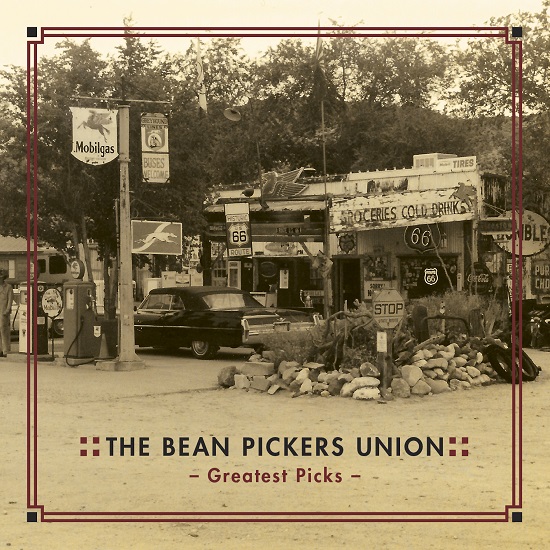
We’ve seen artists cope in many different ways with the pressures of the pandemic and lockdown; here’s another one. Chuck Melchin has already done the long-distance collaboration thing with Michael Spaly of Green Monroe as the Los Brujos project in 2019, so now he’s pulled together another project. It’s a Bean Pickers Union retrospective, pulling songs from the albums “Potlatch” (2007), “Better the Devil” (2012), “Caterwaul” (2017) and “Archaeology” (2019), As an added bonus, there are four unreleased bonus tracks. With a total of eighteen songs, it’s into double-album territory; fortunately there’s so much great material to choose from over the fourteen-year period that the album has a very cohesive feel that retrospectives often lack.
Describe the album in one word? Varied; there’s a long list of players and an even longer list of instruments used. The arrangements and stylings cover most of the Americana spectrum and a bit more besides; “Independence Day” is a full-on rock band arrangement with over-driven guitars and keyboards, hinting at Bruce and the E Street Band musically and even lyrically with a story of cars, girls, beer and marriage in a small American town. Chuck Melchin is a songwriter who knows how to tell a story in a 3-minute song and has a sure touch with his subjects, picking out uncommon themes that are still relatively easy to relate to.
A perfect example is “Philemon”, the story of a survivalist left stranded in the wilderness when Armageddon didn’t actually come. The minimalist backing sets the tone beautifully for the quiet desperation of a man left with only his bible, his ammunition and his shattered illusions. The menacing “Reaper”, starting with sampled surface noise, is a murder ballad telling the story of two friends who take different paths with tragic consequences and ends with violent death. “Warrior” is, on the surface, the tale of a Confederate soldier returning after the Civil War. The martial drums set the tone for the piece, while the intro hints at Al Wilson’s soul classic, “The Snake”. It’s a familiar tale, and a very angry one, of the wounded warrior spurned by society that still happens today with veterans from Vietnam, the Gulf and Afghanistan.
These offbeat tales are mixed with personal material and acute observations, leaving a very rounded and satisfying impression. It’s eighteen well-crafted songs covering a wide range of styles and themes and that’s more than enough to keep any serious music fan happy.
“Greatest Picks” is out now.
Here’s the video for “Warrior”:
 This started the way the best features do, as a conversation in the pub. We’ll let Allan take it from there.
This started the way the best features do, as a conversation in the pub. We’ll let Allan take it from there.
It’s one of the oldest tricks in the pop music book; if the song’s on its last legs and you still need another thirty seconds or so to get you up to the optimal time for radio play, then you deploy one the producer’s most potent tactical weapons – the trucker’s gear change. In its most basic form, the whole arrangement shifts up a tone or a semitone, to grab back your attention before the chorus repeats and fades. Usually, it just happens once, but that depends on how desperate you are (or how weak the song is). You might even get some clever stuff going on to get from one key to the next; when that happens, you get all classical and call it a modulation. What do they sound like? Let’s start with an absolute clunker.
“I Will Always Love You” – Whitney Houston
Considering the quality of the musicians available to producer David Foster, this TGC is bone-jarringly unsubtle; there’s no attempt to pretty it up by repeating a riff in the new key or moving through a few passing chords. Oh no; old key/bang/new key – we’re done. As if that’s not enough, there’s a whole bar of almost complete silence before the melody crashes back in again, maybe David Foster thought that the average listener couldn’t remember which key the song was in after 4 beats. Who knows; anyway it’s a crash/bang/wallop of the highest order and you can hear the teeth grinding off the flywheel:
“Love on Top” – Beyonce
OK, we’re now well and truly in the era of digital recording and production and it’s much easier and quicker to manipulate sounds. You can do a TGC with a mouse-click. If it’s so easy to do, why not do loads of them – one is good, two must be better. Beyonce co-produced this with Shea Taylor, so she’s sharing the blame here. In the last ninety seconds of the radio edit there are four, yes four upward key shifts as the chorus is repeated. It makes you wonder what it would be like if the key shift just kept repeating. As it happens, someone thought of that. Here it is with fourteen upward shifts:
“The Snake” – Al Wilson
Ah, the old Northern Soul classic. Fans will remember that one of the UK pressings of this song had a cover of the John Fogerty classic “Lodi” on the b-side. That’s not relevant, just me showing off. Sometimes you can get away with a few stick shifts if you’re building up to the climax of the song and that’s what happens here. At the end of the second verse, there’s a bass riff which is then repeated a tone higher and you’re in a different key. It’s not just a chorus repeated in exactly the same way but higher, it’s part of the process of moving the story along. And the same device is repeated at the end of the third chorus into the final verse as the song reaches its dramatic finale. Maybe I’m biased, but I think this is part of the arrangement of the song and that keeps it out of Room 101:
“Heat Treatment” – Graham Parker & the Rumour
You might think that any key change part way through a song would be agreed with the writer; it ain’t necessarily so. This was the title song of GP and the Rumour’s second album “Heat Treatment”, released in 1976, the same year as his debut “Howlin’ Wind” (two albums in a year and incessant gigs; musicians grafted in those days). Partway through the song, there’s a modulation; it’s quite musical – a two-bar horn section phrase takes the song up a tone. It’s not lumpy but it does the job fairly quickly. The problem is that it’s not part of generating extra excitement, just the opposite. It takes the song into a bass riff breakdown and the groove has to be built up again from scratch. Graham Parker made his feelings about it known when the album was remastered for CD; his sleeve notes refer to it as ‘that abusive key change’. Fair enough.
“Up the Junction” – Squeeze
This was the title track from the second Squeeze album, with a tip of the hat to Nell Dunn who wrote the novella of the same name. Glenn Tilbrook and Chris Difford were just beginning to realise their potential as songwriters and Jools Holland was still their keyboard player. This is a key change that is about as far from a trucker’s gear change as you can get. It’s a modulation that reflects a downbeat turn in the lyrics through a ten-bar bridge using minor chords before dropping a whole tone for a more upbeat verse and then, paradoxically, going back up by a whole tone for the downbeat final verse. Difford and Tilbrook characteristically messing with the conventions. Bits of “Up the Junction” trivia? There are no choruses and the title of the song doesn’t appear in the lyric until the last three words:


